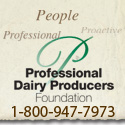 |
 |

|
|
|
South Dakota Ag News Headlines |
 |
Diminishing Personal Injury on Dairy Farms
South Dakota Ag Connection - 12/12/2017
When training dairy employees about proper livestock handling practices, it is important to remind them that if animals are not handled properly they can cause injuries to employees, explained Tracey Erickson, SDSU Extension Dairy Field Specialist.
"Within the dairy industry there is a high percentage of contact time between animals and human beings on a daily basis, and like in other high-risk jobs, employees need to be aware of their surroundings at all times and implement safety practices and
procedures," Erickson said.
So, what type of injuries can happen when working on a dairy? Erickson said typical animal-related dairy injuries are the result of being stepped on, kicked, fallen on, crushed by cows, mauled by dairy bulls or gored by animals that have not been dehorned.
Flight zone: Because dairy cattle have binocular vision, meaning they are able to see all the way around themselves, except for a small blind spot at the nose and rear of the animal, it is important to know how to approach an animal.
Approach the animal from the side, while using verbal cues such as speaking softly, that will minimize spooking an animal.
Understand how to use the "flight zone" in a proper manner which can help facilitate moving an animal in a desired direction.
The flight zone is often referred to as an animal's "personal space."
In essence entering the flight zone will cause the animal to move away from you. Which happens when a person "applies pressure" by stepping into the flight zone or the animals "personal space."
Learning the flight zone penetration area will take some practice.
Noise Sensitivity: Cattle are very sensitive to noise and higher frequency of noises than humans.
Yelling causes stress to animals and can make them more difficult to handle. Staying quiet and calm will help minimize these reactions.
Additionally, unexpected loud noises such as banging gates, loud exhaust from air cylinders, etc. may startle animals.
One way to help condition cattle is to keep a radio playing in the background at a low level in the barn to help reduce the reaction to strange, sudden noises. This can be a very effective tool when training cattle for show and being in fair situations.
Isolation: Cattle are herd animals, so isolation may cause an animal to be nervous, stressed or agitated. When working with an animal, having another companion animal near will help keep the animal being treated calmer.
Past Experiences: Cattle do remember painful or frightening experiences. So, if an area of the barn brings up unpleasant memories for a cow, such as pokes, slipping or rough handling, they may become unwilling to cooperate when they return to that same area.
Warning Signs: Good livestock handlers should be able to watch for warning signs of an agitated animal.
Cattle will react with a raised head or pinned ears, raised tails, raised hair on back, exposed teeth, excessive bawling, pawing the ground and snorting.
Proper Livestock Handling Reminders
Appropriate livestock handling behavior includes:
- Slow and deliberate behavior;
- No loud noises or quick movements;
- Do not prod an animal when it has no place to go;
- Gently touching animals will have a more favorable response than shoving or bumping them;
- We need to respect animals and not fear them;
- Intact male animals, especially dairy bulls, should be considered potentially dangerous at all times and proper equipment and facilities should be made available to assure safety of handlers;
- Breeding animals tend to become highly protective of their young especially when giving birth.
- Animals will defend their territory and this should be kept in mind at all time, given the size, mass, strength, and speed of an animal; and
- Cows will typically kick forward and out to the side and will also have the tendency to kick toward the side where they have pain from inflammation or injuries. Thus, if a cow has a single quarter with mastitis you may want to approach her from the opposite
side of the non-affected udder when examining her or utilize proper restraint to avoid being hurt.
Personal hygiene is extremely important as humans can contract some diseases from livestock.
Diseases such as leptospirosis, rabies and ring worm are fairly common, whereas anthrax and bovine tuberculosis are rare but still exist.
Using personal protective equipment such as splash guards, eye wash stations, gloves and wash stations will minimize disease along with good hygiene by livestock handlers.
Dead animals should be disposed of in a timely and proper manner to minimize the spread or potential exposure to a disease.
Using appropriate livestock handling equipment is a must.
Equipment such as man-gates in pens, working/squeeze chutes, treatment pens, halters, head-gates, anti-kicking devices, hip lifters or cattle lifters should be available and in proper working order.
Make sure that employees are trained on proper use of this equipment.
Facility design is also important including gate placement, pen size, spacing between railings or boards and lighting.
Other South Dakota Headlines
|
|
 |


|
 |
|
Copyright © 2024 - Farms.com. All Rights Reserved. |
 |
|